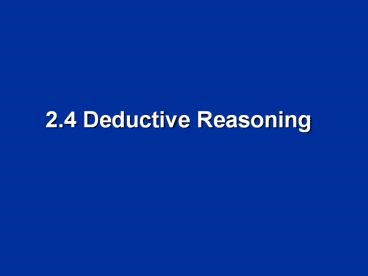Interactive Chalkboard - PowerPoint PPT Presentation
1 / 18
Title:
Interactive Chalkboard
Description:
Title: Interactive Chalkboard Subject: Geometry Author: Glencoe/McGraw-Hill, Inc. Last modified by: randolphr Created Date: 1/18/2002 6:33:30 PM Document presentation ... – PowerPoint PPT presentation
Number of Views:123
Avg rating:3.0/5.0
Title: Interactive Chalkboard
1
2.4 Deductive Reasoning
2
Objectives
- Use the Law of Detachment
- Use the Law of Syllogism
3
Deductive Reasoning
- Recall, in previous sections we used inductive
reasoning (finding examples to make a conjecture)
to present arguments. - Another method is
- Deductive Reasoning a form of argument in
which facts, rules, definitions, or properties
are used to reach logical conclusions (i.e. think
Sherlock Holmes, Encyclopedia Brown, CSI)
4
Law of Detachment
- Law of Detachment a form of deductive reasoning
that is used to draw conclusions from true
conditional statements - If p ? q is true and p is true, then q is also
true. - (p ? q) p ? q
- Basically, you determine the validity of the
conditional before you test the validity of the
conclusion.
5
Example 1a
The following is a true conditional. Determine
whether the conclusion is valid based on the
given information. Explain your reasoning. If
two segments are congruent and the second segment
is congruent to a third segment, then the first
segment is also congruent to the third segment.
Answer Since the conditional is true and the
hypothesis is true, the conclusion is valid.
6
Example 1b
The following is a true conditional. Determine
whether the conclusion is valid based on the
given information. Explain your reasoning. If
two segments are congruent and the second segment
is congruent to a third segment, then the first
segment is also congruent to the third segment.
Answer According to the hypothesis for the
conditional, you must have two pairs of congruent
segments. The given only has one pair of
congruent segments. Therefore, the conclusion is
not valid.
7
Your Turn
Answer not valid
Answer valid
8
Law of Syllogism
- Law of Syllogism a law of logic which uses the
Transitive Property of Equality (if a b
and b c, then a c) - If p ? q and q ? r are true, then p ? r is
true.(p ? q) (q ? r) ? (p ? r)
9
Example 2a
Answer This is an example of the law of
syllogism. If the first statement is true, then
since the second statement used the conclusion of
the first as its hypothesis, then its conclusion
becomes true.
10
Example 2b
Answer There is no valid conclusion. While both
statements may be true, the conclusion of each
statement is not used as the hypothesis of the
other.
11
Your Turn
Use the Law of Syllogism to determine whether a
valid conclusion can be reached from each set of
statements. a. (1) If you ride a bus, then you
attend school. (2) If you ride a bus, then
you go to work. b. (1) If your alarm clock
goes off in the morning, then you will
get out of bed. (2) You will eat breakfast,
if you get out of bed.
Answer invalid
Answer valid
12
Example 3a
13
Example 3a
p the sum of the squares of the two sides of a
triangle is equal to the square of the third side
q the triangle is a right triangle
Answer Statement (3) is a valid conclusion by
the Law of Detachment
14
Example 3b
15
Example 3b
p Ling wants to participate in the wrestling
competition
q he will have to meet an extra three times a
week to practice
r he cannot take karate lessons
Answer Statement (3) is a valid conclusion by
the Law of Syllogism.
16
Your Turn
Answer Law of Syllogism
17
Your Turn
Answer Law of Detachment
18
Assignment
- Geometry Pgs. 84 85 4 27
- Pre-AP Geometry
- Pgs. 85 86 12 - 30































